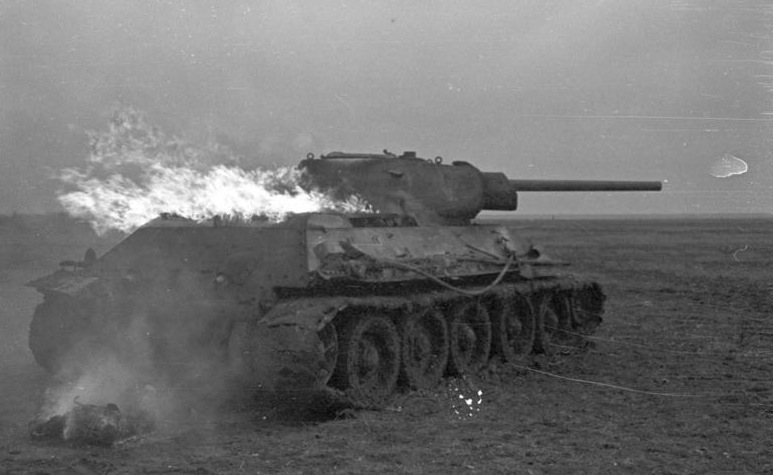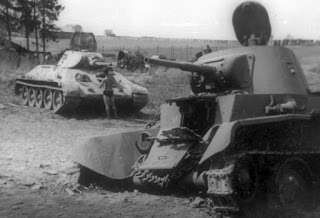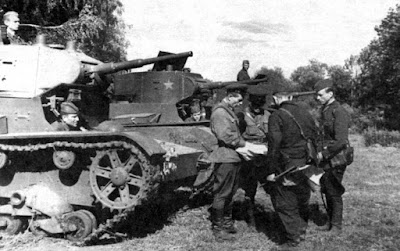
The Southwestern Front, under the command of General Mikhail Kirponos, had received incomplete intelligence on the size and direction of the German attack. They were surprised when Stavka ordered a general counter-attack under the title of "Directive No. 3" on the authority of Chief of General Staff Georgy Zhukov. Most of the headquarters staff were convinced that the strategy would be to remain in a defensive posture until the situation clarified. Later Hovhannes Baghramyan, a staff officer of the front headquarters who wrote the initial report to Moscow, said that "our first combat report to Moscow was full of generalities and unclear instructions." The general orders of Directive No. 3 read:
While maintaining strong defense of the state border with Hungary, the 5th and 6th armies are to carry out concentric strikes in the direction of Lublin, utilizing at least five mechanized corps and aviation of the Front, in order to encircle and destroy the enemy group of forces advancing along the Vladimir-Volynski-Krystonopol front, and by the end of June 24th to capture the vicinity of Lublin.
By the end of 22 June, Zhukov was on his way to the Southwestern Front headquarters at Ternopil along with Nikita Khrushchev, the former head of the Organizational Department of the Ukrainian Communist Party's Central Committee, to ensure these orders were carried out.
Disposition of forces
Six Soviet mechanized corps, with over 2,500 tanks, were massed to take part in a concentric counter-attack through the flanks of Panzer Group 1. The intention was to later attempt a pincer movement from the north (Soviet 5th Army) and south (6th Army) that met west of Dubno in order to trap units of the 6th and 17th German Armies on the northern flank of Army Group South. To achieve this, the 8th Mechanized Corps was transferred from the command of the 26th Army, positioned to the south of the 6th Army, and placed under the command of N. I. Muzychenko's 6th Army. This essentially brought all the mobile assets of the Southwestern Front to bear against the base of von Kleist's thrust toward Kiev. The primary German infantry formation operating on this sector of the front, IV Army Corps (von Schwedler) of the 17th Army (Carl-Heinrich von Stülpnagel) were advancing south-east with the objective of cutting Lviv-Kiev railway line.
Brodyn taistelu (tunnetaan myös nimillä Dubnan taistelu, Dubnon taistelu, Rovnen taistelu ja Rovne-Brodyn taistelu) oli toisessa maailmansodassa Saksan ja Neuvostoliiton joukkojen välinen panssaritaistelu, joka käytiin Brodyn, Dubnon ja Lutskin kaupunkien lähistöllä itärintamalla kesäkuussa 1941.
Taistelussa kohtasivat Saksan 1. panssariryhmä, III armeijakunta ja XLVIII panssariarmeijakunta, sekä viisi Neuvostoliiton mekanisoitujen joukkojen osastoa.
Taistelu alkoi 23. kesäkuuta 1941 ja päättyi saksalaisten voittoon 30. kesäkuuta 1941. Taistelussa saksalaiset kohtasivat ensimmäistä kertaa Neuvostoliiton T-34-panssarivaunuja. Taistelussa saksalaiset menettivät noin 200 panssarivaunua ja Neuvostoliitto yli 800 panssarivaunua
Vaunuja vertailtaessa voidaan todeta että:
T-27, T-37, T-38, T-30 ja T-40 olivat saman tasoisia ja vastasivat Saksan Pz-I ja Pz-II vaunuja. Kuitenkin Pz-II vaunun 20 mm tykki läpäisi T-26, BT-3, BT-5 ja BT-7 vaunut läheltä ja oli hieman tehokkaampi, kuin (T-30 ja T-40) tankkien tykit
T-26 ja BT vaujen 45 mm tykki läpäisi Pz-35, Pz-38, Pz-III ja Pz-IV etu panssarit 500 metrin etäisyys, tornien sivu noin 1000 metrin etäisyydeltä ja lähes samaan kykeni saksalaisten 37 mm tykki.
Pääosa saksan Pz-III vaunuista oli varustettu 50 mm tykillä, jonka putken pituus oli 42 kaliberia, ja joka pystyi tuhoamaan T-26 ja BT vaunut hyvin helposti. Tykin teho oli lähes sama, kuin soviet 45mm tykin läpäisykyky
Suurin osa Pz-III-vaunuista oli varustettu 50 mm tykki, joiden putken pituus oli 42 kaliiperia ja pystyi helposti tuhoamaan T-26- ja BT-vaunut. Aseen teho oli lähes sama kuin neuvostoliiton 45 mm tykin.
Saksan Pz-IV ja Stu-III vaunuissa oli lyhytputkinen 75 mm tykki, putken pituus 24 kaliberi mittaa. Tykki läpäisykyky oli huonompi, kuin soviet 45mm tykin.
Neuvostoliiton T-34 ja KV-1 vaunut pystyivät tuhoamaan saksalaiset vaunut yli 1000 metrin etäisyydeltä Saksalaisten tykit ei edestä kyenneet tuhoamaan näitä vaunuja.
Vain saksan 50 mm tykki L/42 kykeni läipäisemään sivulta näiden vaunujen panssarit, lyhyeltä etäisyydeltä.
Saksalaisissa tankeissa oli erittäin hyvät viestivälineet ja yksi selkeä johtaja, joten vaunujen johtaminen taistelussa oli mahdollista ja hyvin helppoa radioiden ansiosta.
Neuvostoliiton tankeissa ei ollut radioita ja ja niissä oli vähemmän miehiä, lisäksi ne olivat lähes "sokeita", etenkin lähietäisyydeltä, ja tämä seikka asia säilyi aina sodan loppuun asti.
Tilasto-asteikko alla: Brodyn tärkein taistelu seuraavasti.
22. kesäkuuta 1941 säiliöiden tasapaino Saksan armeijaryhmän eteläpuolella ja Neuvostoliiton läntisen rintaman alue mukaan lukien, mutta rajoittumatta
Comparing the wagons:
T-27, T-37, T-38, T-30 and T-40 were of the same level, like the German Pz-I and Pz-II wagons. However Pz-II wagons 20 mm cannon destroy the T-26 BT-3, BT-5 and BT-7, when shootings the close, and was slightly more powerful than the (T-30 and T-40) tank guns
T-26 and BT-7 tank 45mm gun destroyed Pz-I and Pz-II wagon at 1000 meter distance,
and Pz-35, Pz-38, Pz-III, Pz-IV front armor 500 m distance and tower side about 1000 m distance. Near same distance, German 37mm gun, destroyed T-26 ja BT wagons.
Mostly of the Pz-III carriages was 50 mm cannon, with a pipe length of 42 caliber and can easily destroy T-26 and BT wagons. The gun power was almost same like soviet 45mm cannon
German Pz-IV and Stu-III wagons had a short tube 75 mm cannon, tube length 24 caliber. Gun penetration was worse than the soviet 45mm cannon.
German guns not are ability destroy these wagons from the front, only 50 mm cannon L / 42 can destroy soviet T-34 and KV-I tank, able flank of the wagons armor short distance and only both sides and rear.
1941 June, starter the Pz-III model-J manufacture with a 50mm (L / 60) long pipe cannon, but this not pass the KV-1 and T-34 hulls and turret from the front.
Red Armies tanks are overwhelming until end of june 1942.
Large numerous superiority are Soviet tanks, over throughout the war.
The German tanks had very good communication tools and one clear leader, so german wagons are very easy handle at battle time, thanks to the radios.
The Soviet tanks had no radios, and they had two men the turret, and they tanks were almost "blind", especially close proximity, a fact that always remained until the end of the war.
---------------------------------------------------
On 22 June 1941, the balance of tanks over the entire area of the German Army Group South and the Soviet Southwestern Front, including but not limited to the main battle of Brody, was as follows.
| German corps | German divisions | Total German tanks[a] | Tanks with 37 mm cannon (incl. Panzer 38(t) and Panzer III) | Tanks with 50 mm or larger cannon (incl. Panzer III and Panzer IV) |
|---|---|---|---|---|
| III Panzer Corps | 13th, 14th | 296 | 42 | 140 |
| XXXXVIII Panzer Corps | 11th, 16th | 289 | 47 | 135 |
| XIV Panzer Corps | 9th | 143 | 11 | 80 |
| Any other unit of Army Group South | 0 | 0 | 0 | |
| Total | 728 | 100 | 355 | |
| Soviet corps[2] | Soviet divisions | Total Soviet tanks | T-34 and KV |
|---|---|---|---|
| 4th Mechanized Corps (Soviet Union) | only 8th Tank Division participated | 300 | 100 |
| 8th Mechanized Corps (Soviet Union) | 7th | 899 | 171 |
| 9th Mechanized Corps (Soviet Union) | 131st | 316 | 0 |
| 15th Mechanized Corps (Soviet Union) | 10th, 37th Tank Division|37th, 212th Rifle Division|212th | 749 | 136 |
| 19th Mechanized Corps (Soviet Union) | 40th, 43rd, 213th | 453 | 5 |
| 22nd Mechanized Corps (Soviet Union) | 19th, 41st, 215th | 712 | 31 |
| Tanks scattered over various other units | Ordinary rifle divisions, etc. | not incl. | – |
| Total | 3429 | 443 |
At the beginning of Operation Barbarossa, German armor was composed of a mix of Czech and German tanks, as well as small numbers of captured French and British tanks. Furthermore, nearly 50% of the tanks deployed by the Wehrmacht were the virtually obsolete Panzer I and Panzer II light tanks. Of the 4000 armored vehicles available to the Wehrmacht, only 1400 were the new Panzer III and Panzer IV. In the first few hours of the invasion, German commanders were shocked to find that some Soviet tanks were immune to all anti tank weapons in use by the Wehrmacht.
During pre-war exercises, Heinz Guderian noted that on their own, tanks were very vulnerable to infantry. Furthermore, Guderian also noted that tanks lacked the heavy caliber weapons needed to knock out reinforced concrete bunkers and heavily fortified positions, a role that could only be performed by heavy artillery or air strikes. While dispersing tanks among infantry formations solved many of the tank's weaknesses, it also negated some of their strengths. Therefore, German military theorists concluded that to reach their full potential, armored units needed to be concentrated in their own formations and integrated with mobile artillery, mobile infantry, and close air support.
Lastly, Guderian concluded that in order for tanks to be at their peak effectiveness, all armored vehicles must be equipped with radios so that each tank commander can hear instructions from the unit commander allowing each tank to work with all others in an organized fashion.
Soviet Armor
At the beginning of June, the Red Army included over 19,000 tanks in their inventory, most of them light tanks such as the T-26 or BT-7. The front armor of the T-26 was just 15mm thick, and the BT-7, just 22mm, offering virtually no protection against any anti-tank weapon at any range. Furthermore, the poor design of Soviet shells meant that most rounds shattered on contact, rather than detonating. More modern tanks, such as the KV-1 and the T-34, were only beginning to roll off production lines and were not available in anywhere near the numbers that were needed to throw back the German advance.
During the interwar years, far sighted military theorists such as Mikhail Tukhachevsky came to similar conclusions as Heinz Guderian regarding tanks in modern warfare. However, during the Great Purge Tukhachevsky was executed. Red Army tanks were dispersed widely throughout infantry divisions in the 1930s. Then came the shock of the Fall of France. Surviving armored warfare theorists such as Konstantin Rokossovsky were quickly and quietly reinstated in their positions and began assembling tanks into concentrated formations with all possible speed. However, by June 1941 this process was barely half complete, so many of the 10,000 tanks in the Red Army arsenal were still dispersed among infantry divisions on the eve of the invasion. This ensured that even if the Red Army had a unified command, many of its armored units would be committed piece-meal.
German Logistics
At full strength, a German Panzer Division was a balanced formation with between 150 and 200 tanks, motorized infantry, motorized artillery, and motorized engineers. To support its logistical needs, each panzer division included 2000 trucks.
Soviet Logistics
In the immediate pre-war period, few preparations were made and the Red Army was at a very low level of readiness. Units were not concentrated; ammunition and other supply dumps were neither concealed nor quickly available to combat units. Compounding the problem was that Stalin strictly forbade any Red Army unit from opening fire on reconnaissance patrols, allowing the Germans to easily identify all major targets in the border districts.
Soviet tank crews were not adequately trained, and units had not had realistic preparations for movement, resupply or fighting. Those units that did manage to show up at their jumping off points often found that supplies of fuel and ammunition were not available.
----------------------------
Comparing the wagons:
T-27, T-37, T-38, T-30 and T-40 were of the same level, like the German Pz-I and Pz-II wagons. However Pz-II wagons 20 mm cannon destroy the T-26 BT-3, BT-5 and BT-7, when shootings the close, and was slightly more powerful than the (T-30 and T-40) tank guns
T-26 and BT-7 tank 45mm gun destroyed Pz-I and Pz-II wagon at 1000 meter distance,
and Pz-35, Pz-38, Pz-III, Pz-IV front armor 500 m distance and tower side about 1000 m distance. Near same distance, German 37mm gun, destroyed T-26 ja BT wagons.
Mostly of the Pz-III carriages was 50 mm cannon, with a pipe length of 42 caliber and can easily destroy T-26 and BT wagons. The gun power was almost same like soviet 45mm cannon
German Pz-IV and Stu-III wagons had a short tube 75 mm cannon, tube length 24 caliber. Gun penetration was worse than the soviet 45mm cannon.
German guns not are ability destroy these wagons from the front, only 50 mm cannon L / 42 can destroy soviet T-34 and KV-I tank, able flank of the wagons armor short distance and only both sides and rear.
1941 June, starter the Pz-III model-J manufacture with a 50mm (L / 60) long pipe cannon, but this not pass the KV-1 and T-34 hulls and turret from the front.
Red Armies tanks are overwhelming until end of june 1942.
Large numerous superiority are Soviet tanks, over throughout the war.
The German tanks had very good communication tools and one clear leader, so german wagons are very easy handle at battle time, thanks to the radios.
The Soviet tanks had no radios, and they had two men the turret, and they tanks were almost "blind", especially close proximity, a fact that always remained until the end of the war


The battle between Panzer Group 1 and the Soviet mechanized corps was the fiercest of the whole invasion, lasting four full days. The Soviets fought furiously and crews of German tank and anti-tank guns found to their horror that the new Soviet T-34 tanks were almost immune to their weapons. The new KV-1 and KV-2 heavy tanks were impervious to virtually all German anti-tank weapons, but the Red Army's logistics had completely broken down due to Luftwaffe attacks.
The German Kampfgeschwader bomber wings, namely KG 51, KG 54, and KG 55, contributed a series of heavy low-level attacks against Soviet ground targets. The headquarters of the Soviet 15th Mechanised Corps was destroyed, and its commander, General-Major Ignat Karpezo, was wounded. The Luftwaffe destroyed some 201 Soviet tanks in this area.
The five Red Army corps were mishandled while being concentrated into large powerful groups. The German troops sought to isolate individual units and destroy them. Meanwhile, the Luftwaffe ranging over the battlefields was able to separate the supporting infantry and deny them resupply of fuel and ammunition. Ultimately due to lack of adequate planning and overall coordination, the Soviet counter-attack failed to meet at Dubno.






































Nice, 1941 this is when history starts to get interesting lol
VastaaPoistaHi.
PoistaI just read, how german attacked before Stalin
Stalin had planned (2nd version) to start an attack on June 22, 1941, in Europe
And there were a lot of troops, near the western border and of course the Polish and the Czechoslovak border..
(Annoying, this my English-language, because it's made google translator)